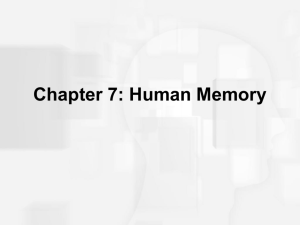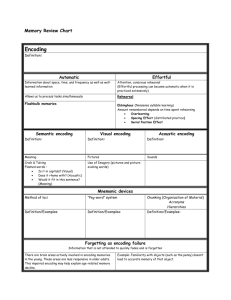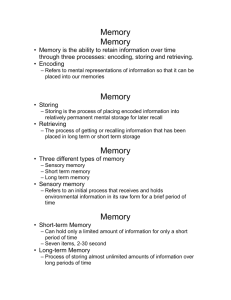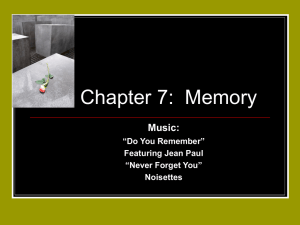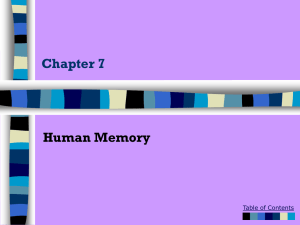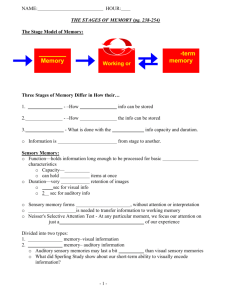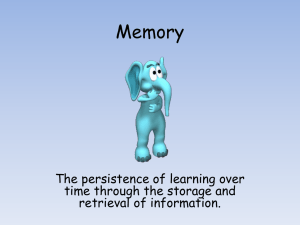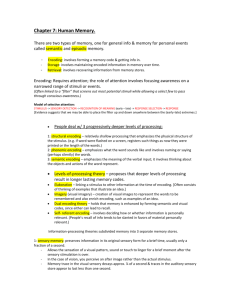File
advertisement
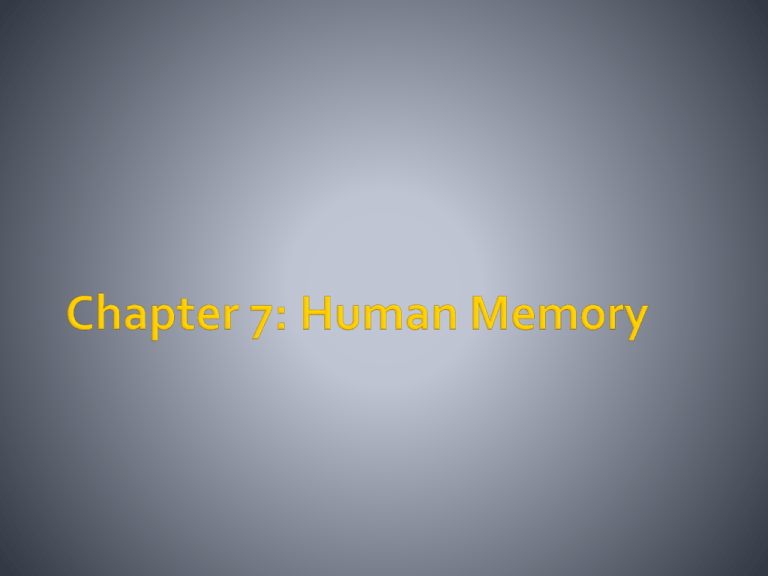
PICK UP A SLIP FROM THE FRONT End of the Year Calendar Review (1 Chapter to go!) Vocabulary Assignment Memory Activity Notes VII. Cognition (8–10%) AP students in psychology should be able to do the following: • Compare and contrast various cognitive processes: ▪ ▪ ▪ — effortful versus automatic processing; — deep versus shallow processing; — focused versus divided attention. • Describe and differentiate psychological and physiological systems of memory (e.g., short-term memory, procedural memory). • Outline the principles that underlie effective encoding, storage, and construction of memories. • Describe strategies for memory improvement. • Synthesize how biological, cognitive, and cultural factors converge to facilitate acquisition, development, and use of language. • Identify problem-solving strategies as well as factors that influence their effectiveness. • List the characteristics of creative thought and creative thinkers. • Identify key contributors in cognitive psychology (e.g., Noam Chomsky, Hermann Ebbinghaus, Wolfgang Köhler, Elizabeth Loftus, George A. Miller). How does information get into memory? How is information maintained in memory? How is information pulled back out of memory? Figure 7.2 Three key processes in memory The role of attention Focusing awareness Selective attention = selection of input Filtering: early or late? https://www.youtube.com/watch?v=fO7WcGsKhFU Figure 7.3 Models of selective attention Incoming information processed at different levels Deeper processing = longer lasting memory codes Encoding levels: Structural = shallow Phonemic = intermediate Semantic = deep Figure 7.4 Levels-of-processing theory Figure 7.5 Retention at three levels of processing Elaboration = linking a stimulus to other information at the time of encoding Thinking of examples Visual Imagery = creation of visual images to represent words to be remembered Easier for concrete objects: Dual-coding theory Self-Referent Encoding Making information personally meaningful START RESEARCHING METHODS OF HOW TO EFFECTIVELY STUDY VOCABULARY Have out your notes and a blank piece of paper! Sensory & Short Term & Long Term Memory George Miller “Magic Number 7” Activities Common Memory Phenomena Baddeley’s 3 Systems VII. Cognition (8–10%) AP students in psychology should be able to do the following: • Compare and contrast various cognitive processes: — effortful versus automatic processing; — deep versus shallow processing; — focused versus divided attention. • Describe and differentiate psychological and physiological systems of memory (e.g., short-term memory, procedural memory). • Outline the principles that underlie effective encoding, storage, and construction of memories. • Describe strategies for memory improvement. • Synthesize how biological, cognitive, and cultural factors converge to facilitate acquisition, development, and use of language. • Identify problem-solving strategies as well as factors that influence their effectiveness. • List the characteristics of creative thought and creative thinkers. • Identify key contributors in cognitive psychology (e.g., Noam Chomsky, Hermann Ebbinghaus, Wolfgang Köhler, Elizabeth Loftus, George A. Miller). Analogy: information storage in computers ~ information storage in human memory Information-processing theories Subdivide memory into 3 different stores ▪ Sensory, Short-term, Long-term Figure 7.7 The Atkinson and Schiffrin model of memory storage Brief preservation of information in original sensory form Auditory/Visual – approximately ¼ second George Sperling (1960) ▪ Classic experiment on visual sensory store ▪ Iconic memory and cued recall Figure 7.8 Sperling’s (1960) study of sensory memory Limited capacity – magical number 7 plus or minus 2 Chunking – grouping familiar stimuli for storage as a single unit Limited duration – about 20 seconds without rehearsal Rehearsal – the process of repetitively verbalizing or thinking about the information https://faculty.washington.edu/c hudler/stm0.html George Miller’s “The Magical Number 7-Plus or Minus 2” Figure 7.9 Peterson and Peterson’s (1959) study of short-term memory STM not limited to phonemic encoding Loss of information not only due to decay Baddeley (1986) – 3 components of working memory Phonological rehearsal loop Visuospatial sketchpad Executive control system Permanent storage? Flashbulb memories Recall through hypnosis Debate: are STM and LTM really different? Phonemic vs. Semantic encoding Decay vs. Interference based forgetting Clustering and Conceptual Hierarchies Schemas and Scripts Semantic Networks Connectionist Networks and PDP Models Memory Loci- MEMORY PALACE OMG http://www.ted.com/talks/joshua_foer_feats_of_memory_anyone_c an_do The tip-of-the-tongue phenomenon – a failure in retrieval Retrieval cues Recalling an event Context cues Reconstructing memories Misinformation effect ▪ Source monitoring, reality monitoring ▪ https://www.youtube.com/watch?v=gCswq5JDTaw ▪ https://www.youtube.com/watch?v=x6fRH5MLBIU http://www.pbs.org/newshour/updates/newly -released-witness-testimony-tell-us-michaelbrown-shooting/ Grouchy Gabby Fearful Smiley Jumpy Hopeful Sleepy Shy Droopy Dopey Sniffy Wishful Puffy Dumpy Lazy Pop Grumpy Bashful Cheerful Teach Shorty Sneezy Nifty Happy Doc Wheezy Stubby Shambly Ugly Fatty Crazy Sleezy Retention – the proportion of material retained Recall Recognition Relearning Ebbinghaus’s Forgetting Curve Figure 7.16 Ebbinghaus’ forgetting curve for nonsense syllables Figure 7.17 Recognition versus recall in the measurement of retention Ineffective Encoding Decay theory Interference theory Proactive Retroactive Figure 7.19 Retroactive and proactive interference Figure 7.20 Estimates of the prevalence of childhood physical and sexual abuse Encoding Specificity Transfer-Appropriate Processing Repression Authenticity of repressed memories? Memory illusions Controversy Figure 7.22 The prevalence of false memories observed by Roediger and McDermott (1995) Biochemistry Alteration in synaptic transmission ▪ Hormones modulating neurotransmitter systems ▪ Protein synthesis Neural circuitry Localized neural circuits ▪ Reusable pathways in the brain ▪ Long-term potentiation Anatomy Anterograde and Retrograde Amnesia ▪ Cerebral cortex, Prefrontal cortex, Hippocampus, ▪ Dentate gyrus, Amygdala, Cerebellum Figure 7.23 The anatomy of memory Figure 7.25 Retrograde versus anterograde amnesia Declarative vs. Procedural Semantic vs. Episodic Prospective vs. Retrospective Figure 7.26 Theories of independent memory systems Engage in adequate rehearsal Distribute practice and minimize interference Emphasize deep processing and transferappropriate processing Organize information Use verbal mnemonics Use visual mnemonics
